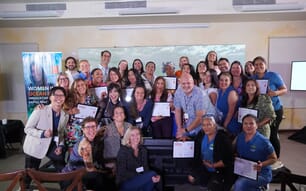Linden Jack from the Food Hygiene Policy Branch, Hygiene and Microbiology Division, of the FSA told the recent Shellfish Association of Great Britain annual conferenc4e in London that there is a strong need for a robust system, which protects public health, is practical to apply and does not place a disproportionate burden on shellfish harvesters.
He said that there are clearly practical difficulties with applying current system, many of which are long term issues.
He said that delays in response to high results, which produce downgrades of the safety status of the beds, can have a major impact on industry but he said it is questionable whether they actually provide additional public health protection.
Mr Jack said that the current system is resource intensive and with two thirds of the harvesting beds around the UK shores stable, there is a climate for change to bring in better regulation.
Since the end of last year the authorities and the harvesters have been meeting to draw up a new classification system.
At present production areas are categorised by the level of microbiological contamination - the level of E. coli contamination found in shellfish sampled from a site.
These areas are classified as Class A, B, C or prohibited:
- Class A - shellfish contain less than 230 E. coli per 100 grams of flesh
- Class B - shellfish contain less than 4,600 E. coli per 100 grams of flesh
- Class C - shellfish contain less than 46,000 E. coli per 100 grams of flesh
- Prohibited area - above 46,000 E. coli per 100 grams of flesh
A workshop that took place in February this year has identified some areas for improvements, which Mr Jack said could be progressed swiftly.
He said it was a longterm project that could take up to three years to implement and ensure that the new classification system complies with legislation.
Mr Jack said that there are several short term prtecedural measurs that can be implemented swiftly, but there is also more investigation needed for more medium and long term measures.
There are three possible ways in which the standards can be laid down either by having the data from harvesters' samples collected and testing to be used to allocate classification or that harvesters collect samples on behalf enforcement authorities, which are then tested according to enforcement authority protocols or that the enforcement authorities collect and test samples.
However, he said that the same protocol should be used for all samples taken to generate data for the classification.
The preferred route would be for the harvesters to pilot the protocol to ensure that it is practical and to establish a way that data from the harvesters sampling can be used.
Where beds fall into the C category and the products are going for heat treatment, primarily for cockle harvesting, the protocol could follow a risk based approach, so that resources can be targeted at areas where thee is a greater risk.
Mr Linden called for a proportionate approach to reviewing the classification system, particularly where high risk results are found.
He said there is a more reactive approach to high risk areas, but the enforcement authorities should move away from an examination and downgrading approach to these areas.
Such an approach can be highly expensive and have a heavy impact on the harvesters as the downgrading for public health protection can be damaging for a long period of time.
"A high result should still be investigated but should temporary closures with an agreed protocol for re-opening rather than downgrading area should be considered," said Mr Jack.
He added that there is a need for an acceptance that continued monitoring may show water quality is deteriorating and then a downgrade will be needed.
There is also a need to reduce the time taken to classify new beds and the time that a sanitary survey takes.
A protocol for the industry is expected within the next few months.
Longer term moves that are hoped to start this year will use mussel beds as indicators and is to look at regular risk-based sampling.
The authorities will have to consider options, which would allow the active management of harvesting beds and the development of guidance on applying risk based measures to support active management.
However, he said this is likely to take time and resources to implement including changes in testing methods and in implementing sanitary surveys.




